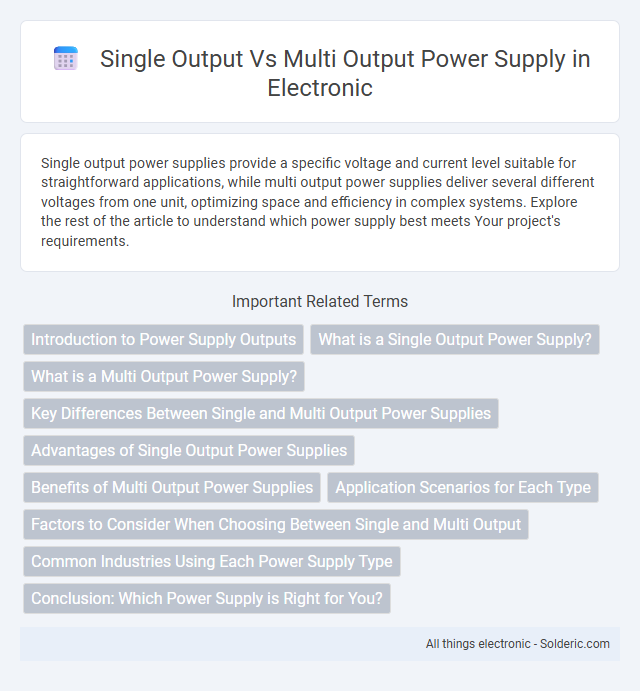Single output power supplies provide a specific voltage and current level suitable for straightforward applications, while multi output power supplies deliver several different voltages from one unit, optimizing space and efficiency in complex systems. Explore the rest of the article to understand which power supply best meets Your project's requirements.
Comparison Table
| Feature | Single Output Power Supply | Multi Output Power Supply |
|---|---|---|
| Number of Outputs | One regulated output voltage | Multiple regulated output voltages |
| Use Case | Simple applications, single voltage requirement | Complex systems needing multiple voltage rails |
| Cost | Generally lower cost | Higher cost due to complexity |
| Design Complexity | Simple design, easy integration | Complex design, requires careful load balancing |
| Space Efficiency | Takes more space if multiple supplies needed | Space-saving by combining outputs in one unit |
| Load Regulation | Better regulation on a single output | Requires design to minimize cross-load interference |
| Application Examples | LED drivers, simple circuits | Embedded systems, industrial electronics |
Introduction to Power Supply Outputs
Single output power supplies provide a fixed voltage or current from one output terminal, making them ideal for applications requiring a stable and straightforward power source. Multi output power supplies deliver multiple voltages or currents simultaneously from separate outputs, enabling complex systems to be powered with different voltage levels from a single unit. The choice between single and multi output power supplies depends on the design requirements, such as the number of devices powered and the need for isolated or common ground outputs.
What is a Single Output Power Supply?
A single output power supply provides a fixed or adjustable voltage through one output terminal, delivering power to a specific component or device. It is commonly used in applications requiring a stable and consistent power source, such as LED lighting, small appliances, or electronics testing. Your choice of a single output power supply ensures reliable performance when only one voltage level is needed.
What is a Multi Output Power Supply?
A multi output power supply provides several independent voltage outputs from a single power source, allowing different components within a system to receive the specific power levels they require. Each output is regulated separately to ensure stable voltage and current, improving efficiency and reducing the need for multiple power adapters. This type of power supply is commonly used in complex electronics, telecommunications, and industrial automation where diverse power needs must be met simultaneously.
Key Differences Between Single and Multi Output Power Supplies
Single output power supplies deliver a fixed voltage or current from a single output channel, ideal for applications requiring consistent power parameters. Multi output power supplies provide multiple independent outputs with varying voltages or currents, enabling simultaneous powering of different components or circuits. The key differences lie in complexity, flexibility, and cost, with multi output units offering greater versatility at higher expense and design intricacy compared to simpler, more affordable single output models.
Advantages of Single Output Power Supplies
Single output power supplies offer simplicity and cost-efficiency, making them ideal for applications requiring stable voltage and current without complexity. Their design enables easier troubleshooting and higher reliability due to fewer components and connections. Additionally, single output units typically provide better regulation and noise performance for dedicated devices.
Benefits of Multi Output Power Supplies
Multi output power supplies deliver multiple voltage levels from a single unit, enhancing space efficiency and reducing the overall system footprint. They simplify complex designs by minimizing the need for multiple power sources, lowering installation and maintenance costs. This versatility improves reliability and allows for more streamlined power management in multi-component electronic systems.
Application Scenarios for Each Type
Single output power supplies are ideal for applications that require a stable voltage or current for a single device, such as LED lighting, simple electronic circuits, and small home appliances. Multi output power supplies support multiple voltage rails simultaneously, making them suitable for complex systems like computer motherboards, telecommunications equipment, and industrial automation where diverse voltage levels are essential. Choosing the appropriate power supply depends on the complexity and power requirements of the application, optimizing efficiency and performance.
Factors to Consider When Choosing Between Single and Multi Output
Choosing between single output and multi output power supplies depends on your specific application requirements, including the number of voltage rails needed, total power capacity, and space constraints. Single output power supplies are ideal for devices requiring a single, stable voltage, offering simplicity and often higher efficiency, while multi output supplies provide multiple voltages from one unit, reducing wiring complexity and saving space in multi-rail systems. Consider your load type, regulation accuracy, and potential future expansion when selecting the most suitable power supply to ensure optimal performance and reliability.
Common Industries Using Each Power Supply Type
Single output power supplies are predominantly used in industries like telecommunications, consumer electronics, and industrial automation where stable voltage for a single device or circuit is critical. Multi output power supplies find extensive applications in medical equipment, aerospace, and test and measurement sectors, providing varied voltages simultaneously for complex systems. Both types ensure efficient power management tailored to specific operational requirements across diverse industrial environments.
Conclusion: Which Power Supply is Right for You?
Choosing between single output and multi output power supplies depends on your device requirements and circuit complexity. Single output power supplies provide stable voltage for simple, dedicated applications, ensuring efficiency and cost-effectiveness. Multi output power supplies suit complex systems needing various voltages simultaneously, reducing component count and enhancing integration for advanced electronics.
Single Output vs Multi Output Power Supply Infographic

 solderic.com
solderic.com